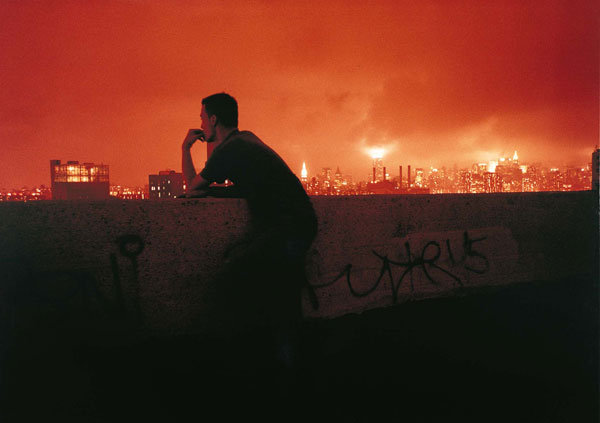Mean Streets (Malas Calles)
dal 9/2/2010 al 8/5/2010
Segnalato da
IVAM Institut Valencia' d'Art Modern
Allan Sekula
Jeff Wall
Rem Koolhaas
Paul Graham
Michael Ashkin
Grupo de Arte Callejero
Gabriel Basilico
Peter Eisenman
Cindy Sherman
Philip Lorca di Corcia
Martha Rosler
David Wojnarowicz
William Kentridge
Aldo van Eyck
Gilliam Wearing
Wolfgang Tillmans
Dan Graham
Peter Cook
Vito Acconci
Constant
Gordon Matta Clark
Yona Friedman
Edward Ruscha
Cesar Domela
Valentina Kulangina
Gustav Klucies
Paul Joostens
Walker Evans
Horacio Coppola
George Grosz
Carlos Garaicoa
Jose' Miguel Garcia Cortes
9/2/2010
Mean Streets (Malas Calles)
IVAM Instituto Valenciano de Arte Moderno, Valencia
A global and interdisciplinary view on public space

Curator: José Miguel García Cortés
The exhibition project MALAS CALLES presents a global and interdisciplinary
view of how public space and city streets and squares have been represented
during the last century. Streets are some of the most important elements in the
urban fabric; the changes they undertake, the events that take place in them
and the structure they have are all basic points to understand essential aspects
of city life. If one knows about the modifications and changes that have taken
place in streets for the last decades, we will gain a better and thorough
understanding of human feelings and experiences.
The catalogue of the exhibition compiles the works on display and includes
texts by Manuel Delgado, Vicente Sánchez-Biosca, Juan Antonio Suárez,
Consuelo Císcar and José Miguel García Cortés, the curator of the exhibition.
In MALAS CALLES we can follow an itinerary that starts at the beginning of the
21st century and continues (or rather, it goes back) until the first decades of the
20th century. It is a journey through four main stages that reveal the different
states of mind, spirit, attitudes and patterns of behaviour that have organised
and structured life in Western cities for years. It is a journey that takes us from
joy and hope in the 20’s and the 30’s to lethargy and scepticism in recent years.
These are the four stages of the project:
1) The game is over: this section compiles artistic expressions from recent
years which evidence an attitude of strangeness and urban isolation and
loneliness. Here we can see the most modern proposals, which reflect the most
fragile and hopeless view of life in cities. Some of the works are by, among
others, Allan Sekula, Jeff Wall, Rem Koolhaas, Paul Graham, Michael Ashkin,
Grupo de Arte Callejero, Gabriel Basilico and Peter Eisenman.
2) The street belongs to us: this part focuses on the works by different artists
who have portrayed the wish of different social groups to make themselves
visible and occupy city streets and squares. Here we can find works by artists
and architects such as Cindy Sherman, Philip Lorca di Corcia, Martha Rosler,
David Wojnarowicz, William Kentridge, Aldo van Eyck, Gilliam Wearing and
Wolfgang Tillmans.
3) Between utopia and disenchantment: it focuses on the 50’s and 60’s and
refers both to the visionary architecture projects that understood cities as
organisms free from any ties and to more pessimistic and disenchanted
proposals. We can see works by Guy Debord, Dan Graham, Peter Cook, Vito
Acconci, Constant, Gordon Matta Clark, Yona Friedman and Edward Ruscha.
4) In the middle of the crowd: this section represents the faith in progress and
modernity that lay behind the construction of cities in the first half of the 20th
century, as well as the presence of crowds in the streets. Photographs by
Cesar Domela, Valentina Kulangina, Gustav Klucies, Paul Joostens, Walker
Evans and Horacio Coppola establish a relationship with drawings and
watercolors by George Grosz and a modern art installation by Carlos Garaicoa.
The exhibition originates from an interdisciplinary point of view in the conception
of cities and the (pernicious) streets in them. Thus, the different artistic
expressions (photography, video art and drawing) support and complement
each other together with a wide selection of films (La Haine, La Zona, Rumble
Fish, Do the Right Thing, Metropolis, Play Time, Berlin: Symphony of a Great
City and Man with a Movie Camera), literary works (by writers like Don Delillo,
Roberto Bolaño, Carlos Monsiváis, Tom Spanbauer, J. G. Ballard, Edgar Allan
Poe, James Joyce and Alfred Döblin), and songs (by Boris Vian, Ella Fitzgerald,
Laura Nyro, David Bowie, The Smiths, Lou Reed, Chemical Brothers and Public
Enemy) from each of the periods. Thanks to this the different sections offer a
wide and thorough view of the artistic representation of life in Western city
streets in the last century.
IVAM Institut Valencià d’Art Modern
Guillem de Castro, 118 - 46003 Valencia
Opening Hours:
Tuesday to Sunday: 10 am to 8 pm
Monday: closed
General entrance: 2,00
Students / Student card: 1,00
Retired people: Free entrance
Civic and cultural groups (advanced booking): Free entrance
Other groups: 1,50 per person
Handicap: Free entrance
Sundays: Free entrance



